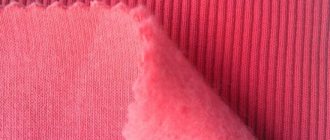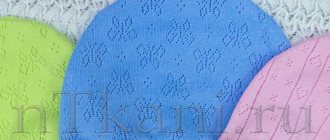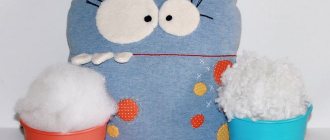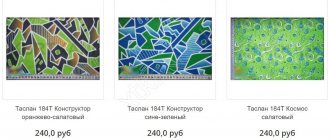History of creation and types of polyester
Polyester fibers
Developments to create durable fibers for the textile industry began back in the 30s. English scientists succeeded best of all, who, through chemical reactions through a multi-stage combination of monomers present in oil, obtained a new generation of fibers.
The name polyester is found not only on clothing labels; plastic food containers, packaging bags, and much more are made from this substance. Depending on the temperature, polyester fibers can take on different thicknesses and densities. Even for the textile industry they are produced in several versions:
- volumetric threads;
- staple;
- monofilaments, which are produced by extruding liquid polyester through special nozzles with holes of different thicknesses;
- filament fibers (many craftswomen use them for machine embroidery);
- textured threads.
The variety of properties of polyester fibers makes it possible to produce from them fabrics for sewing underwear and bed linen, outerwear, toys, insulation for shoes and winter jackets (for example, padding polyester or holophane).
It is important to know : consumers know it under different names: dacron, tesil, lavsan, diolene and others, but their properties are the same.
The most popular grades of polyester:
- Polyester Microfiber is a fabric created by weaving the finest threads, which makes it very light and durable.
- Polyester Mini Mesh is a mesh lining material that is used when sewing sportswear. It creates the necessary aeration and removes excess moisture from the body during sports.
- Polyester Peach Washer is a fabric that has the same properties as the first type, only its surface is velvety and delicate.
- Polyester Polar Fleece is an unstructured type of fabric that has increased strength and a smooth surface that is pleasant to the touch.
- Polyester / PVC - the back side of this type of fabric is additionally treated with polyvinyl chloride, which significantly increases its strength and moisture resistance.
- Polyester Tricot - the material has shown excellent results with long-term use and numerous washes. Very durable: products made from it do not lose their shape and color for a long time.
- Polyester Tricot Shiny is a fabric that, in addition to the qualities listed above, has a characteristic shine.
These types of polyester are most often found on clothing labels. They guarantee that the item will last a long time and retain its original appearance and color even after repeated washing.
Description and properties
To improve properties during production, polyester is combined with cotton, viscose, and wool.
Types: Duspo-impregnated with polyurethane; protects from wind, dirt and repels water. Jordan has increased wear resistance due to the addition of polyurethane. Impervious to wind and water. The surface is iridescent. Bonding is a dense but breathable fabric that retains heat well. Used for sewing children's outerwear. Prince is waterproof and windproof with a matte surface. File is a very dense water- and windproof, quick-drying fabric. Retains its appearance and shape for a long time. Trilobal is used to make clothes for women and children as it has a pearlescent tint. Memory fabric has the memory of a previous action (for example, creasing). Taffeta is used for sewing workwear because it is resistant to chemicals and water.
Polyester is a fabric of synthetic origin. Externally similar to wool or cotton fabric. It is durable, wears for a long time, is lightweight and almost does not wrinkle.
Physical parameters
Decomposition temperature - 350 C Melting temperature - 250-265 C Percentage of moisture absorption - 0.3% Dissolves in toluene, acetone, benzene, ethyl acetate. Elongation percentage - up to 55% Density - 1.4g/cm3
Having such characteristics, deformation of the fabric occurs during washing at temperatures above 40 C. Therefore, products made from it are washed at low temperatures.
This property can be attributed to both minuses and pluses. It is used by designers to obtain folds and complex clips in clothing production.
Advantages and disadvantages
Like many artificial fabrics, polyester has its advantages and disadvantages:
- Wear resistance
- Strength
- Resistant to fading
- No pellets are formed
- Dries quickly after washing
- Does not change shape when worn
- Has dirt- and water-repellent properties
- Not affected by harmful insects
- Resistant to solvents and acids.
Negative sides:
- Does not allow or does not allow air to pass through
- Difficult to paint
- Electrified
- Hard
- Low quality polyester fibers can be harmful to health.
Polyester production technology
Polyester for sportswear
When creating polyester, different components of products obtained from oil refining are used. This is a rather complex chemical process that involves ethylene glycol and dimethyl terephthalate. Diglycol ether, when heated to +270 degrees, goes through the stage of polycondensation (during this process, high-molecular compounds are formed). The melted fibers are treated with ethylene oxide, which is produced by catalytic oxidation.
After a series of chemical processes, polystyrene is formed. From this, in turn, polyester fibers are produced by melting and cooling with air. The next stage is stretching the resulting synthetic threads to the required thickness and strength.
Polyester fabric is created by weaving transverse and warp threads, but such fabric is rarely used. More often, natural or synthetic threads are added to polyester fibers during the weaving process. This gives the material a number of unique properties.
Description of fabric
Polyester down jacket
For a long time, polyester was used as packaging film or bags, and the American company DuPont began its truly commercial production. Fabrics made from its fibers are resistant to ultraviolet radiation, retain their color for a long time, are durable and are not afraid of pests, fungi and moths.
Polyester is stain resistant and stains can be easily removed when washed. However, like other synthetic types of fabrics, it has both advantages and disadvantages.
Pros and cons of polyester clothing
Polyester retains color even when exposed to ultraviolet light.
The following advantages of polyester material can be noted when used in clothing:
- long term wear of products;
- strength and lightness of things;
- safety for humans;
- excellent ability to retain color even when exposed to ultraviolet radiation;
- absolute resistance to attacks by moths and other insects;
- does not require ironing and dries quickly;
- does not deteriorate when exposed to acids and solvents.
Polyester does not “breathe” and is quite hard to the touch.
However, such clothing is not without some disadvantages:
- does not allow air to pass through well;
- electrostatic;
- hard to the touch.
It can be noted that clothes made of polyester have many pros and cons, so whether or not to use it in your own wardrobe is up to each person to decide for themselves.
Advantages of polyester
The chemical industry does not stand still, so every year new combinations of natural and synthetic fabrics with the addition of polyester fibers appear. In its pure form, this material is rarely used for a number of reasons, but even it has qualities that any consumer will appreciate, for example:
- it is durable and wear-resistant;
- it is easy to care for;
- it is not affected by acids and weak alkalis;
- does not lose shape with prolonged wear;
- does not stretch after washing;
- dries quickly;
- heat resistant;
- it is resistant to dirt and does not roll down;
- practically does not allow moisture to pass through, which makes it suitable for sewing winter and demi-season outerwear;
- does not fade in the sun.
Clothing designers use fabrics with polyester when the style requires maintaining folds and shape, which this material is famous for, but it also has a number of disadvantages.
Polyester spandex. What kind of material is this?
Another synthetic material to consider is spandex. What kind of material this is, you can figure out if you consider its composition, which includes polyurethane fibers, as well as cotton and linen threads.
The following advantages of this material can be noted:
- absolute strength;
- ability to maintain shape;
- extensibility;
- wear resistance;
- smooth surface and shine;
- crease resistance;
- ability to repel dirt.
Separately, it should be noted that spandex has the ability to withstand cutting perfectly without crumbling during this procedure. In addition, it absolutely does not take on the temperature of the human body, due to which it remains pleasantly cool even in the middle of a hot summer day. However, do not forget that this fabric is prone to the formation of puffs, and can also cause allergic reactions in people.
Polyester combined with other fabrics
When polyester fibers are mixed with any types of threads, new types of materials are formed, for example:
- A mixture of polyamide and polyester forms a fabric that looks like silk. It is elastic, does not deform during prolonged wear, does not fade, but does not allow moisture to pass through and is electrified. Most often it is used in the manufacture of women's underwear.
- In combination with elastane, stockings and tights, tracksuits and gloves are sewn from it. The fabric stretches well, allows air to pass through, but can be of any density.
- When cotton threads are woven with polyester, the fabric becomes stronger, does not wrinkle, unlike natural linen, does not deform and does not fade. In this combination, the material becomes amenable to dyeing in any color, which makes it the best option for sewing bed linen.
- In combination with viscose fibers, the result is a fabric that does not fade or lose its shape after prolonged use. It is used to make casual clothing for leisure, home or work.
It is important to know : for every fiber with which polyester is mixed, it improves the original properties, adding its own positive qualities.
The textile industry continues to surprise its consumers with new types of fabrics every year, but if even a small percentage of polyester is written on the label, the product can be purchased, as it will serve its owner for a long time.
What is single-sided polyester
Polyester fiber, which has only one side that can be the front side and contain a pattern or just a shade, is called single-sided. If inclusions of viscose or linen are added to this material, then it becomes double-sided, which means that the boundaries of its application are significantly expanded, and it receives additional properties.
In conclusion, it should be noted that polyester is a modern synthetic fiber that embodies all the achievements of modern science and has become a real discovery among fabrics for both personal and industrial use. Such materials have excellent strength and practicality characteristics, which makes them absolutely indispensable in modern life.
Application of fabric
Polyester umbrella
Depending on how the material containing polyester will be used, it is impregnated with special agents, imparting the necessary properties. For example, the main characteristics of fabrics for sewing workwear are strength, lightness, good aeration and ease of care.
Among the most popular materials for work suits are:
- Oxford, a combination of nylon and polyester, is used to make summer robes and warm work jackets. Among its positive qualities are strength, resistance to temperature differences and chemicals.
- A mixture of cotton and varying percentages of polyester fibers creates fabrics from which workwear is sewn for working in dusty indoor spaces. They are durable, wash well, do not deform during long-term use and do not need ironing. These include Tomboy, Greta and Twill.
- For uniforms that require not only comfort, but also elegance, for example, the clothing of waiters, flight attendants, medical workers and office employees, a fabric consisting of a mixture of viscose and polyester is used.
For other areas of activity or leisure, the textile industry produces fabrics with polyester:
- For sewing everyday clothes - shirts, dresses, trousers, jackets, underwear and hosiery.
- They are indispensable in the manufacture of tracksuits and autumn-winter outerwear.
- They are used to produce home textiles, such as curtains, tablecloths, bed linen, blankets and bedspreads.
- You can’t do without them when making umbrellas, gloves and bags.
- They are used to make toys and camping supplies such as tents, backpacks and sleeping bags.
The scope of application of fabrics with polyester fibers is very wide due to their unique properties. One of them is the ease of care of the finished product.
Caring for polyester products
Although materials created from a mixture of various fibers with polyester are low maintenance, there are several conditions that must be met.
- Almost all products containing a percentage of polyester are machine washable, but there are exceptions, so when purchasing, you need to carefully study the label. If hand washing is required, it is carried out in a warm soapy solution.
- Basically, the water for washing polyester items does not exceed +40 degrees, except in cases where the fabric is impregnated with a special mixture for high temperatures, for example, in workwear.
- Polyester fabrics cannot be bleached, but it is recommended to add fabric softener, which makes them softer and reduces their electrification properties.
- Products made from such fabrics do not need ironing; just shake them after washing and hang them to dry.
Thanks to polyester fibers, modern fabrics have become not only stronger and more beautiful, but also cheaper than natural materials. Their percentage indicated on the label provides information on how much the material has been improved with their help. For tailoring this is 2-30%, in other products it can be up to 50-100%, for example, in the manufacture of insulation.
Are polyester clothes breathable or not?
The material made from polyester is very popular even though it is not very breathable. The material, which contains 100% polyester, is synthetic and does not allow air to pass through at all. Therefore, clothes made from such fiber are not made to be worn in the summer.
It is not recommended to wear clothes made of pure polyester in summer.
Nevertheless, other types of products are excellently used by people in different areas of life, largely due to the following qualities:
- elasticity;
- ability to maintain shape;
- resistance to getting wet;
- drying speed.
Do not forget that polyester fibers can be combined with other materials. For example, a combination with cotton significantly increases the fabric's ability to breathe through, which makes it quite suitable for creating summer clothing.
Separately, it should be noted that there are three ball fabrics that contain not only polyester, but also nylon, and are additionally impregnated with certain substances that improve their breathability.











